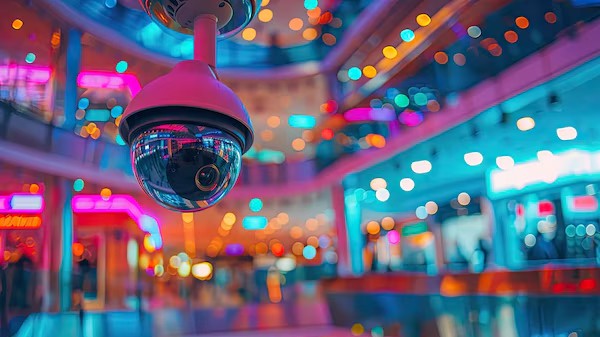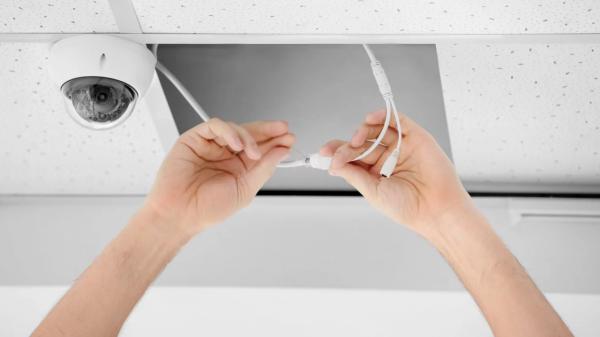

Security Cameras: A Comprehensive Overview of Types and Features
Security cameras are available in various shapes, sizes, and functionalities, making them suitable for a wide range of situations and environments. These surveillance devices can be categorized based on movement, dimensions, functionalities, and housing types. It is essential to understand that security cameras can fall into multiple categories and may offer diverse features.
Fixed Cameras
Fixed security cameras remain in a set position throughout their operational life. The only means of repositioning them is through physical remounting or adjustments, ensuring consistent monitoring of a designated area. Additionally, the term "fixed" can pertain to the type of lens, which does not allow for adjustments in focal length, angle, or zoom. Most fixed lens cameras feature wide-angle lenses. In contrast, varifocal lenses enable flexibility in these aspects.
Applications: Ideal for continuous monitoring of a specific location.
Advantages: Cost-effective and straightforward, fixed cameras require minimal installation effort; users simply mount the camera and direct it toward the target area without needing further adjustments.
Disadvantages: These cameras cannot capture footage outside their frame unless manually repositioned. Furthermore, digital zooming can lead to pixelation if the camera's resolution is low.
Manual Varifocal Cameras
Manual varifocal lenses allow users to adjust the focal length, enabling a tailored horizontal field of view. This feature is particularly useful for gaining detailed visuals from a distance.
Applications: Perfect for situations where detail is crucial, such as capturing license plate information from a distance.
Advantages: Users can customize the level of detail in their recordings, limited only by the camera's megapixel rating.
Disadvantages: Adjustments require physically detaching the lens to achieve the desired focal length.
Motorized Varifocal Cameras
Often referred to as zoom lenses, these cameras enable focal length adjustments through user-friendly software, allowing for real-time modifications based on movement or user input.
Applications: Users can dynamically focus on specific details as needed, whether manually or automatically.
Advantages: Zoom lenses offer a broader adjustment range compared to manual varifocal lenses and are a cost-effective alternative to PTZ cameras.
Disadvantages: Though they allow for zoom adjustments, motorized varifocal cameras still have limited field coverage since the camera itself remains stationary.
PTZ (Pan-Tilt-Zoom) Cameras
PTZ cameras can be remotely controlled to pan, tilt, and zoom, offering comprehensive surveillance capabilities. They are often used in conjunction with fixed cameras for broader coverage.
Applications: Ideal for monitoring expansive areas, commonly deployed in public spaces.
Advantages: These versatile cameras can track moving subjects and provide 360-degree coverage. They can also follow predefined paths, enhancing monitoring efficiency.
Disadvantages: Despite their extensive coverage, PTZ cameras are among the most expensive options. Their operation relies heavily on software and motors, which can complicate setup and maintenance.
Bullet Cameras
Bullet security cameras, often known as box or shoebox cameras, are widely used for their conspicuous design, which can deter unwanted behavior by making subjects aware of their surveillance.
Applications: Suitable for both indoor and outdoor use, depending on their IP rating.
Advantages: They come in various designs and offer customizable lens options for focused or wide-angle shots.
Disadvantages: Their overt design may make them susceptible to tampering if placed within reach.
Dome Cameras
Dome cameras offer a discreet design that can be easily installed without requiring additional housing for exposed wiring. The lens may be either fixed or motorized.
Applications: Commonly used in various settings, both indoor and outdoor.
Advantages: Their dome shape obscures the direction they point, making them less vulnerable to tampering.
Disadvantages: Compared to bullet or PTZ cameras, dome cameras provide fewer options for lens customization and lower megapixel ratings.
Turret Cameras
Also known as eyeball cameras, turret cameras feature a ball-and-socket design, allowing them to pivot easily for an adjustable field of view.
Applications: Recommended for users seeking versatility and high image quality.
Advantages: They can be directed in multiple angles after installation, providing a flexible monitoring solution.
Disadvantages: Unlike dome cameras, turret models lack protective casings, making them more vulnerable to vandalism.
Low-Light Cameras
These cameras utilize infrared sensors to capture images in near darkness. Built-in infrared illuminators enhance their functionality in low-light conditions.
Applications: Suitable for monitoring areas with little to no light.
Advantages: They can operate without additional lighting, producing clear footage even in black and white, which can enhance shape and detail recognition.
Disadvantages: While effective in low light, the images are monochrome, unlike WDR cameras, which can provide color images under varied lighting.
WDR (Wide Dynamic Range) Cameras
WDR technology balances exposure levels, allowing these cameras to capture high-quality footage in environments with significant contrast between light and dark areas.
Applications: Ideal for monitoring locations where lighting varies dramatically, such as areas near glass doors or windows.
Advantages: WDR cameras excel at capturing detailed images under challenging lighting conditions, often outperforming human vision.
Disadvantages: They tend to be more expensive and may require intricate configuration for optimal performance.
Thermal Cameras
These devices detect heat emitted by objects and people, allowing them to capture images in conditions where visibility is limited.
Applications: Traditionally used for low-visibility scenarios, they have gained popularity for temperature monitoring during health crises.
Advantages: Effective in foggy or dim environments, they can also screen individuals for elevated body temperatures.
Disadvantages: Thermal cameras do not provide optical clarity; they are specialized and often come with a higher price tag.
4K Security Cameras
These cameras deliver exceptional detail and clarity, providing four times the clarity of standard 1080p systems.
Applications: Commonly used in expansive settings, such as construction sites or events, where detail is paramount.
Advantages: They offer superior image quality and can cover large areas, minimizing the need for multiple installations.
Disadvantages: High-resolution footage can consume significant bandwidth, though users can opt for lower resolutions for smoother playback.
Mobile Security Cameras
Designed for portability, these cameras are housed in weather-resistant casings, enabling users to deploy them wherever needed.
Applications: Suitable for temporary security needs at various locations, including construction sites and events.
Advantages: They can be mounted easily wherever there is a power source.
Disadvantages: In the absence of power, solar options can be costly, and lacking wireless connectivity can complicate footage retrieval.
License Plate Recognition (LPR) Cameras
LPR technology focuses specifically on capturing clear images of license plates, storing them in a searchable database.
Applications: Best for monitoring areas with consistent traffic flow.
Advantages: These cameras save time by automating license plate capture and processing, functioning effectively under various lighting conditions.
Disadvantages: Their functionality is limited solely to license plate recognition.
Interior Camera Housings
These are designed to blend into indoor environments, making installation straightforward without needing additional mounts.
Applications: Ideal for most indoor locations where environmental conditions pose minimal risk.
Advantages: Easy installation and servicing, with typically lower costs involved.
Disadvantages: Unless designed to be tamper-resistant, indoor cameras are more susceptible to damage compared to their outdoor counterparts.
Exterior Camera Housings
Constructed to withstand the elements, exterior cameras are often made from durable materials to ensure longevity.
Applications: Suitable for outdoor installation.
Advantages: They are generally more resilient to vandalism and environmental factors.
Disadvantages: The protective casings make them bulkier and more complicated to install than indoor cameras.
Damage-Resistant Cameras
Damage-resistant cameras are rated for durability in various environments and can withstand elements like water, heat, and physical impact.
Applications: Used in extreme conditions, such as remote areas or hazardous environments.
Advantages: Capable of continuous recording even under stress, ensuring reliable monitoring.
Disadvantages: They may be niche products, often coming at a premium price point.
Articles
All articles
AI Surveillance Systems: Transforming Safety and Operational Efficiency in Modern Shopping Malls
AI Surveillance Systems: Transforming Safety and Operational Efficiency in Modern Shopping Malls

The Advantages of a Comprehensive Home Surveillance System
The Advantages of a Comprehensive Home Surveillance System

Seeing Clearly: The Advantages of 4K Surveillance for Businesses
Seeing Clearly: The Advantages of 4K Surveillance for Businesses

Indoor vs. Outdoor Security Cameras: Making the Right Choice for Your Safety
Indoor vs. Outdoor Security Cameras: Making the Right Choice for Your Safety

The Smart Investment: How Monitored Security Cameras Enhance Business Safety
The Smart Investment: How Monitored Security Cameras Enhance Business Safety

2024 Security Camera Buying Guide: What You Need to Know
2024 Security Camera Buying Guide: What You Need to Know

Essential Guide to Troubleshooting IP Camera Systems
Essential Guide to Troubleshooting IP Camera Systems

Artificial Intelligence: Transforming IP Camera Systems
Artificial Intelligence: Transforming IP Camera Systems

Thermal Cameras: Enhancing Security and Operational Excellence Across Industries
Thermal Cameras: Enhancing Security and Operational Excellence Across Industries

Maximizing Safety and Efficiency: The Impact of IP Camera Systems Across Industries
Maximizing Safety and Efficiency: The Impact of IP Camera Systems Across Industries

Beyond Security: How Surveillance Cameras Transform Shipping and Receiving Operations
Beyond Security: How Surveillance Cameras Transform Shipping and Receiving Operations

Enhancing Safety: The Essential Role of Security Camera Systems in Apartment Complexes
Enhancing Safety: The Essential Role of Security Camera Systems in Apartment Complexes

Is a PTZ Camera the Right Choice for Your Business?
Is a PTZ Camera the Right Choice for Your Business?

Troubleshooting Nighttime Flickering: Understanding Your Security Camera Issues
Troubleshooting Nighttime Flickering: Understanding Your Security Camera Issues

Why Are My Cameras Showing Black and White Images?
Why Are My Cameras Showing Black and White Images?

Safeguarding Your Security Cameras from Hackers
Safeguarding Your Security Cameras from Hackers

A Comprehensive Guide to Security Camera Cabling: Types, Failures, and Solutions
A Comprehensive Guide to Security Camera Cabling: Types, Failures, and Solutions

Securing the Aggregate Industry: The Essential Role of Surveillance Cameras
Securing the Aggregate Industry: The Essential Role of Surveillance Cameras

Security Cameras: A Comprehensive Overview of Types and Features
Security Cameras: A Comprehensive Overview of Types and Features

Protecting Your Car Wash: Essential Security Measures Against Theft and False Claims
Protecting Your Car Wash: Essential Security Measures Against Theft and False Claims
Try TRASSIR For Your Business
Learn more about how TRASSIR analytic modules work! Demo mode is an opportunity to see for yourself how the system works, and also check the interface and test all the functions.Success!
We will contact you as soon as possible